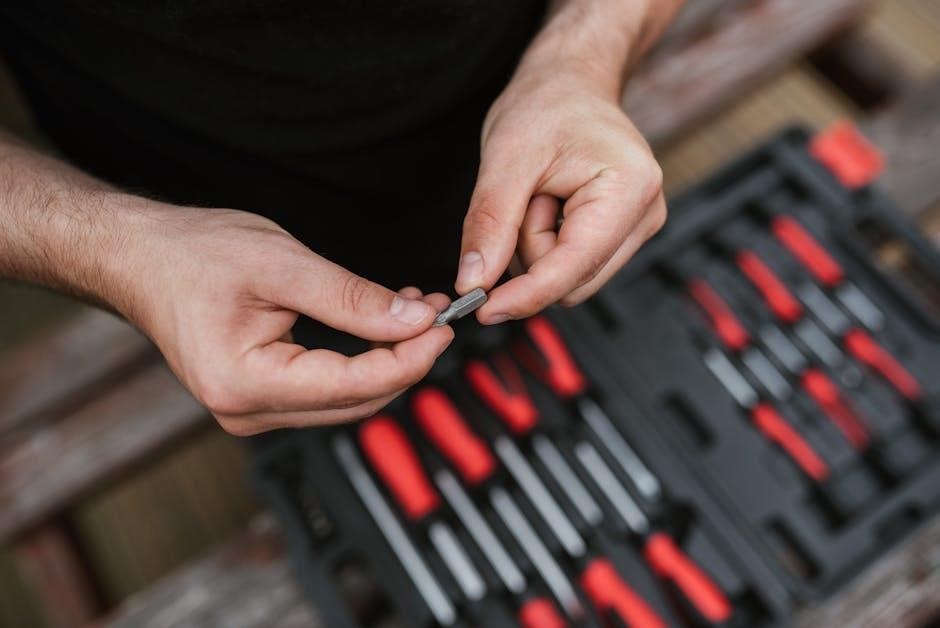The Bair Hugger 775 Service Manual provides comprehensive instructions for maintaining and repairing the 3M Bair Hugger 775 Temperature Management Unit. It includes detailed procedures for troubleshooting, calibration, and replacing parts, ensuring optimal performance and patient safety. Designed for biomedical technicians, this manual is essential for servicing the unit effectively.
Overview of the Bair Hugger 775 Warming Unit
The Bair Hugger 775 Warming Unit is a critical component of the 3M Bair Hugger Temperature Management System, designed to provide precise temperature control for patient warming. It is primarily used in medical settings to prevent hypothermia during surgical procedures. The unit operates by circulating warmed air through specialized blankets or gowns, ensuring consistent and safe heat delivery. Key features include a user-friendly control panel, multiple temperature management modes, and advanced safety mechanisms to prevent overheating. The system also supports optional accessories, such as a rolling stand, for enhanced mobility and convenience. The Bair Hugger 775 is known for its reliability and efficiency in maintaining normothermia, making it a vital tool in perioperative care. Its design integrates seamlessly with other components of the Bair Hugger system, including warming blankets and blood/fluid warming sets, to provide comprehensive temperature management solutions.
Importance of the Service Manual for Maintenance and Repair
The Bair Hugger 775 Service Manual is indispensable for ensuring the optimal performance and longevity of the warming unit. It provides detailed guidance on routine maintenance tasks, such as filter replacements and sensor calibration, which are crucial for maintaining precise temperature control. The manual also includes troubleshooting strategies for common issues, enabling technicians to diagnose and resolve problems efficiently; Additionally, it outlines procedures for emergency shutdowns and fault code clearance, ensuring patient safety and system reliability. By following the manual’s instructions, biomedical technicians can perform repairs and maintenance with confidence, minimizing downtime and extending the unit’s lifespan. Regular servicing, as outlined in the manual, is essential for compliance with safety standards and maintaining the unit’s effectiveness in clinical settings.

Structure and Key Components of the Service Manual
The Bair Hugger 775 Service Manual is organized into clear sections, including installation, operation, and troubleshooting guides, with detailed diagrams and essential information for effective servicing and maintenance.
Organization of the Manual for Easy Navigation
The Bair Hugger 775 Service Manual is meticulously organized to ensure easy navigation and quick access to information. It features a detailed table of contents, dividing the manual into clear sections such as installation, operation, maintenance, and troubleshooting. Each section is further subdivided into specific topics, such as control panel overview, temperature management modes, and replacing wearable parts. The logical flow of the manual guides users from initial setup to advanced servicing, making it user-friendly for both novice and experienced technicians. Key information is highlighted using headings, bullet points, and diagrams, while cross-references direct users to related sections for additional details. This structured approach ensures that users can efficiently locate and understand the information they need to service and maintain the Bair Hugger 775 effectively.
Essential Tools and Equipment Required for Servicing
Servicing the Bair Hugger 775 requires specific tools and equipment to ensure proper maintenance and repair; Essential items include a set of screwdrivers, pliers, and wrenches for disassembling and reassembling components. A multimeter is necessary for troubleshooting electrical issues, while calibration tools are required to ensure accurate temperature readings. Additionally, replacement parts such as filters, hoses, and wearable components should be available. The manual emphasizes the importance of using manufacturer-recommended tools to avoid damaging the unit or compromising safety. A clean, well-lit workspace and protective gear, such as gloves and safety glasses, are also recommended to ensure safe servicing. By having these tools and equipment on hand, technicians can efficiently perform routine maintenance, diagnose issues, and restore the Bair Hugger 775 to optimal functioning condition. Proper preparation is key to successful servicing and maintaining patient safety.

Installation and Setup of the Bair Hugger 775
Connect the unit to a properly grounded power source to initiate the power-on-reset sequence. The device performs self-test functions, illuminates indicators, and displays the MD 700s text momentarily. Follow setup guidelines carefully.
Step-by-Step Installation Instructions
Begin by connecting the Bair Hugger 775 to a properly grounded power source to ensure safety and proper functionality. Once connected, the unit will automatically perform a power-on-reset sequence, which includes self-test functions and a momentary illumination of all indicator lights and alphanumeric display; After the reset, the unit will display “MD 700s” to confirm successful initialization. Next, ensure the warming unit is placed on a stable surface or installed on the optional rolling stand for mobility. Connect any accessories, such as warming blankets or gowns, to the appropriate ports on the unit. Finally, refer to the control panel to configure settings and verify that all systems are operational. Always follow the manual’s guidelines for correct installation to ensure optimal performance and patient safety.
Initial Setup and Configuration Guidelines

After installation, power on the Bair Hugger 775 and allow it to complete the automatic power-on-reset sequence, which includes self-test functions and a brief display of all indicator lights. Navigate to the control panel to configure basic settings, such as temperature ranges and alarm limits, to meet specific clinical requirements. Ensure all safety features, including thermal cutoffs and pressure alarms, are enabled to prevent overheating or system malfunctions. For accurate operation, calibrate the unit as outlined in the service manual. Once configured, test the system by running a diagnostic cycle to verify proper functionality. Regularly review and update settings to maintain optimal performance and patient safety. Always refer to the manual for detailed configuration instructions tailored to your facility’s needs.
Connecting Accessories and Peripherals
Connecting accessories and peripherals to the Bair Hugger 775 is a straightforward process when following the service manual’s guidelines. Begin by ensuring all components, such as warming blankets, gowns, or the Ranger 241 blood/fluid warming set, are compatible with the Model 775 unit. Locate the designated connection ports on the rear or top panel of the warming unit. Securely attach the accessories, ensuring proper alignment and a tight fit to avoid any leaks or disconnections during operation. For fluid warming sets, connect the tubing to the appropriate inlet and outlet ports, taking care to follow the directional arrows. Once connected, perform a system check to verify proper function and airflow. If using optional peripherals like a rolling stand or additional temperature probes, ensure they are securely fastened and calibrated as per the manual. Always refer to the service manual for specific connection diagrams and troubleshooting tips.

Operating the Bair Hugger 775
Operating the Bair Hugger 775 involves using the control panel to set temperature modes, monitor patient warmth, and ensure safety. It features intuitive controls and advanced thermal management.
Control Panel Overview and Key Features
The Bair Hugger 775 control panel is designed for intuitive operation, featuring an alphanumeric display, function buttons, and indicator lights. It allows users to set and monitor temperature, select operating modes, and view system status. The panel provides real-time feedback, ensuring precise control over patient warming. Key features include temperature adjustment, mode selection, and alarms for system monitoring. The display illuminates during power-on self-tests and shows diagnostic messages for easy troubleshooting. The control panel is central to operating the unit efficiently, offering a user-friendly interface for healthcare professionals. Refer to the service manual for detailed instructions on utilizing these features effectively.
Temperature Management Modes and Settings
The Bair Hugger 775 offers multiple temperature management modes to cater to different patient needs. These include standard warming, high-flow warming, and standby modes. Each mode is selectable via the control panel, allowing precise temperature control between 30°C and 43°C. The unit also features adjustable airflow settings to optimize patient comfort. Safety mechanisms ensure temperatures remain within therapeutic ranges, preventing overheating or underheating. The service manual details how to configure these modes and set parameters for specific clinical scenarios. Proper use of these settings ensures effective patient warming while minimizing risks. Always refer to the manual for guidelines on selecting the appropriate mode and temperature range for individual patient requirements. This customization capability makes the Bair Hugger 775 versatile for various medical applications.
Safety Features and Emergency Shutdown Procedures
The Bair Hugger 775 incorporates advanced safety features to ensure patient and operator protection. These include automatic shutdown in case of overheating, blockages, or sensor malfunctions. The unit is equipped with visual and audible alarms to alert staff of potential issues. Emergency shutdown can be initiated by pressing the power button or disconnecting the unit from the power source. The service manual provides detailed instructions for identifying and addressing safety-related faults. Proper understanding of these features is critical for maintaining a safe operating environment. Regular maintenance, as outlined in the manual, helps prevent safety hazards and ensures reliable performance. Always adhere to the manual’s guidelines for emergency procedures to minimize risks and safeguard patients; These safety mechanisms are integral to the unit’s design, ensuring compliance with medical safety standards.

Maintenance and Troubleshooting
Regular maintenance ensures the Bair Hugger 775 operates efficiently. The service manual details tasks like cleaning, checking sensors, and replacing filters, preventing issues before they occur, ensuring reliable performance.
Routine Maintenance Tasks for Optimal Performance
Regular maintenance is crucial for ensuring the Bair Hugger 775 operates efficiently and safely. The service manual outlines essential tasks, including cleaning the unit, inspecting and replacing filters, and checking temperature sensors. It also recommends verifying the integrity of hoses and connections to prevent leaks or airflow issues. Additionally, the manual advises performing software updates and calibrating the unit periodically to maintain accuracy. Users should also monitor the alphanumeric display for fault codes and address them promptly. Routine maintenance not only extends the lifespan of the device but also ensures consistent patient warming performance. By following the manual’s guidelines, technicians can prevent potential issues and maintain optimal functionality of the Bair Hugger 775 Temperature Management Unit.

Troubleshooting Common Issues and Error Codes

The Bair Hugger 775 service manual provides detailed guidance for diagnosing and resolving common issues. Error codes displayed on the alphanumeric screen indicate specific problems, such as temperature inaccuracies or airflow obstructions. Users should first perform a power-on self-test to identify system malfunctions. Common issues include faulty temperature sensors, clogged air filters, or disconnected hoses. The manual recommends checking connections, cleaning or replacing filters, and verifying sensor calibration. For error codes like “E01” or “E02,” the manual offers step-by-step solutions, such as resetting the unit or replacing components. Additionally, it advises consulting the troubleshooting section for specific code interpretations and repair procedures. Addressing issues promptly ensures reliable operation and patient safety. By following the manual’s troubleshooting guidelines, users can efficiently resolve problems and maintain optimal performance of the Bair Hugger 775 Temperature Management Unit.

Replacing Filters, Hoses, and Other Wearable Parts
Regular maintenance of the Bair Hugger 775 involves replacing wearable parts to ensure optimal performance. The service manual provides clear instructions for replacing air filters, hoses, and other components. Filters should be replaced every 500 hours of operation or as indicated by error codes. Hoses must be inspected for cracks or damage and replaced if necessary. The manual outlines the correct tools and procedures for these replacements, ensuring safety and effectiveness. Additionally, it recommends checking other wearable parts, such as seals and gaskets, and replacing them according to the maintenance schedule. Proper disposal of old parts is also emphasized. By following these guidelines, users can maintain the unit’s efficiency and prolong its lifespan. The manual further stresses the importance of using genuine 3M replacement parts to ensure compatibility and reliability. Regular replacement of wearable parts is crucial for consistent operation and patient safety.
The Bair Hugger 775 Service Manual is essential for maintaining and servicing the unit, ensuring optimal performance and patient safety. Adherence to its guidelines guarantees longevity and efficiency, supported by 3M resources.

The Bair Hugger 775 Service Manual emphasizes the importance of regular maintenance, proper troubleshooting, and adherence to safety protocols to ensure optimal performance. Key practices include following the manual’s guidelines for calibration, filter replacement, and error code resolution. Technicians should always refer to the manual before performing any servicing or repairs to avoid potential risks. Additionally, maintaining a record of all maintenance activities is crucial for tracking the unit’s history and ensuring compliance with healthcare standards. By following these best practices, users can extend the lifespan of the Bair Hugger 775 and guarantee reliable operation in clinical settings. Always prioritize patient safety and system efficiency by adhering to the manual’s instructions and recommendations.
Resources for Further Assistance and Support
For additional guidance, the Bair Hugger 775 Service Manual can be downloaded from the 3M website or accessed through authorized medical equipment suppliers. The manual is available in English, French, and German, ensuring accessibility for a global audience. Users can also contact 3M’s customer support for technical inquiries or visit the 3M Bair Hugger therapy website for updated resources and FAQs. Furthermore, the manual directs users to maintenance logs and troubleshooting guides for ongoing support. For complex repairs, it is recommended to consult certified biomedical technicians. The 3M Bair Hugger 775 service manual is a comprehensive resource, but additional tools like the operator’s manual and training materials may be required for full system understanding. Always refer to the official 3M website for the most accurate and up-to-date information.
